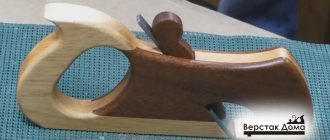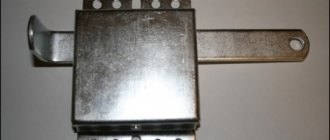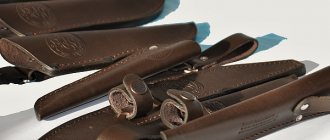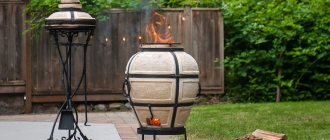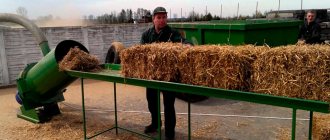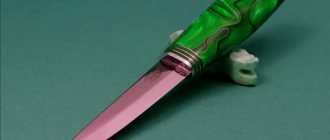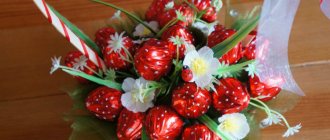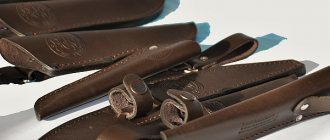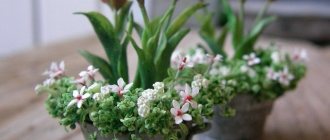We strive to create comfort in our home. Tablecloths, towels, napkins, being an indispensable part of everyday life, additionally saturate the room with warmth and comfort. With the help of these interior elements you can transform the appearance of any room at any time.
Every housewife knows that the atmosphere in the house is created from the little things.
A tablecloth on the table will allow you to fully experience the atmosphere of family warmth and home comfort. In this article we will tell you how to sew napkins and tablecloths for the table with your own hands. Small household items, sewn by yourself, will add a unique personality to the decor of your home.
Ordinary napkins can transform the kitchen and turn everyday meals into cozy family feasts.
Table design features
Table setting is a creative, exciting process. All family members can participate. This activity can be turned into an interesting game. The process of decorating a festive table includes everything: from selecting a tablecloth to arranging cutlery. The latter include napkins. They are an important means of hygiene and help decorate a celebration. They must be purchased and placed according to certain rules.
Decorating models
Tablecloths and napkins can be sewn from thick natural fabric with light lace inserts with flowers added around the entire perimeter. A good addition to the models would be embroidery or appliqué.
You can find many accessories for napkins on sale.
The model with the addition of organza is luxurious, will beautifully decorate the table in the dining room, and will be an appropriate addition to a romantic dinner.
When choosing fabric for napkins, use pieces of material left over from making other products, for example, after making tablecloths.
We will show you how to quickly sew a tablecloth from organza or decorate napkins served on the festive table with it.
Even novice needlewomen of a young age can make such napkins with their own hands.
Organza inserts are usually sewn into the center of the tablecloth or used to decorate the corners of the overhang. A pattern with organza flowers will perfectly complement festive textiles.
Do-it-yourself napkins are most valued.
Choosing fabric
In shops and markets, textile products of different sizes, types, and price categories are sold for table setting. But it will be more effective to make cute napkins with your own hands. This is quite easy to do. The first stage of production is the choice of fabric. The fabric should be light, dense, wear-resistant. It must withstand a large number of washes and not lose its original appearance after several uses. Three types of fabric meet all of the above requirements. They are described in more detail in the table.
Fabric Advantages, disadvantages Cotton As an everyday textile, this is an ideal option. The cotton is not easily soiled, it is dense. It retains its shape and does not wash out. Can last for a long time. The cost of such material is acceptable. Mixed fabrics A practical, inexpensive option. These are fabrics consisting of synthetic and natural raw materials. The percentage of component input may vary. Thanks to mixing, the fabric combines all the advantages of natural and synthetic raw materials. It is wear-resistant. After washing, the material does not shrink. Linen is a natural, beautiful fabric. It has good absorbency and easily retains its shape even after ten washes. Flax is susceptible to starch. The product can be folded into various fancy shapes.
Necessary materials for sewing
To sew textile decorative elements with your own hands, you need a good mood, desire and a few available tools:
- A piece of canvas;
- Sewing machine;
- Basic sewing supplies: scissors, thread, measuring tape, pins, needles;
- Marking pencil;
- Ironing board and iron.
Napkins perform not only a decorative, but also a practical function.
Interesting folding methods
It will be difficult to surprise guests with napkins modestly lying under the plate. Now it is fashionable to fold them into various shapes, flowers, and other extraordinary shapes. The following are the most popular options.
Lily
An original flower will decorate any holiday table.
The starting position of the fabric is folded in half diagonally. The left and right corners are aligned with the vertex of the original triangle. Then you need to fold it in half, just bend the top of the triangle located at the top.
Scheme for assembling a lily from a fabric napkin
South Cross
The Southern Cross is an interesting and very simple fabric napkin layout that will fit perfectly into the decor of the dining table.
The original shape is face down. Bend all corners one by one. They should be facing the center. Then you need to turn the square over and bend the corners again. Then the upper right corner should be pulled out, followed by all the others.
Method of folding napkins “Southern Cross” step by step
Megaphone
Megaphone - a very simple way to design a paper or fabric napkin
Hemstitch on canvas
Now let’s look at how to make hestitching on canvas using a “split” pattern.
The canvas is quite loose, so you need to work with it carefully, otherwise the embroidery can be ruined. But at the same time, such a rare weave will help to complete the drawing correctly, especially for a novice needlewoman.
First you need to learn how to pull out the strings. This is done using a blade, with which we cut about six threads. You should not make a wide hem, as the pattern will be lost in this case.
First we go through one edge. It is better to treat it immediately so that it does not bloom further. Then we decorate the second edge in the same way.
When the outline is prepared, we proceed to the drawing. Let's look at how you can make a hemstitch step by step. For beginners, the “split” pattern will not be difficult to perform. On one side of the embroidery we make a tassel of two threads. We carefully go through the seam so that the loops are clearly visible. On the other side, we connect the threads of different columns into one tassel.
You can combine several strips of embroidery made with different patterns, and if you add colored threads, the pattern will turn out bright.
Accessories
To make napkins a real highlight of the table setting, they can be decorated with original accessories. Accessories can be different: flowers, feathers, clips, rings. With the help of such decorative elements you can create an incredible composition. Use the following guidelines when selecting accessories.
- You should not decorate the feast with artificial flowers. It looks cheap and unattractive. It is better to give preference to fresh flowers, even inexpensive ones. Chamomile, fragrant rose, delicate lily will help create an incredible atmosphere at the table.
- Textile products can be personalized. This idea is relevant when organizing a wedding or birthday. Personalized napkins will be a very pleasant surprise. You can embroider names on the material yourself. For this purpose, contrasting threads are usually used. Another option is to put names out of rhinestones. This is a great party idea.
- Rings are an exquisite accessory. It will become indispensable during a dinner party or an important business event. The advantage of rings is their durability. This accessory is made from durable raw materials. It can be stored in a closet at home, waiting for the right opportunity. Rings come in different sizes and colors. You need to choose a model based on the color of the tablecloth, the interior features of the room, and the table. Every detail of the decor should be in harmony with the serving. Special clamps can be an excellent alternative to rings. Clamps are made in different shapes and colors. They look quite elegant.
- Satin ribbons. Bright satin ribbons go well with beautiful textiles. This is the easiest, most inexpensive way to decorate a table. You just need to tie napkins folded into an interesting shape with ribbons. Additionally, the ribbons can be decorated with rhinestones. They are simply glued to the surface using quick-drying glue.
Finishing the edge of a napkin using hemstitching
Hemstitching is a great way to finish an edge without a visible seam.
Yes, it’s labor-intensive, but how beautiful!
We take a cotton fabric with a uniform weave of thread of the desired size + 3 cm for the hem (mine is 40 x 40 cm, 34 x 34 cm in finished form), we process the edge so that it does not fray during the process.
In this master class I will not describe all the possible variety of hemstitch seams. There is a series of excellent master classes on this topic at the Masters Fair.
In this master class I will look at three elements of edge processing using hemstitching:
- Actually, the edge itself - how to make it beautiful (for this we will make teeth).
- How to make a hem seam invisible (for this we will use openwork zigzags). I'm using one of the simplest stitches to show the principle.
- How to make a corner neat (for this we will design it as an envelope).
Here is the general scheme for pulling the threads. With its help it will be easier to navigate in the further description.
But the general order of pulling the threads and making the sheathing is also for reference.
And now a description of the work in parts:
Teeth along the edge of the napkin.
- At a distance of 3 cm from the edge, in the center, we pick up and cut one thread; pull it out, leaving 3 cm to the edge on each side.
Steps 1 - 4 will need to be repeated for all sides, but first perform steps 5 - 6 for the first side.
5. We fasten the thread with which we will sew the teeth; I use white DMC cotton floss in two folds (the photo specifically shows a contrasting thread).
6. We move from left to right. We grab 4 columns of threads and fix them by stitching from top to bottom and grabbing 2 threads of fabric.
We repeat, we continue, and in the end we get this:
7. When we reach the side on which the thread is not pulled out, we determine which thread should be pulled out so that the distance from the edge is 3 cm and the number of threads on the current side is a multiple of four.
When we fold the hem, the stitched posts form beautiful teeth.
Openwork zigzags - the beginning
- We retreat 1.5 cm inward from the sheathed square and pull out 5 threads.
- On the perpendicular side we also pull out 5 threads.
- In the corner we bring the threads to the wrong side and fasten.
4. Starting from the formed corner, we sew the columns: 2 threads and then 4 each, finishing with two threads.
I use white floss, 1 thread (the photo specifically shows a contrasting thread).
We continue, we repeat, it turns out like this:
Corner of a napkin “envelope”
- Iron the hem on the wrong side (2 times 1.5 cm each) and unfold it.
2. Fold the napkin with the front side inward.
We sew the seam. The main thing is that it is strictly the required length (see diagram).
We cut off the excess fabric parallel to the seam, retreating 1-2 mm.
4. Turn it inside out, helping yourself with a pencil. The hem itself “asks” to be tucked the way it should.
Hems and openwork zigzags - completion
1. Secure the hem with safety pins and iron it.
2. We fasten the thread on the wrong side, in the corner of the envelope and bring it to the front side.
I use one DMC thread in white (the photo specifically shows the contrast thread).
3. We sew the second side of the zigzag hemstitch, starting from the corner, grabbing 4 columns of threads. When fixing the posts, we grab two threads of fabric, as well as two hem threads.
We repeat, we continue. This is what you should get from the front and back sides, respectively:
Already in this form, the napkin is pleasant to use for serving.
Did you like the article? Subscribe to the channel to stay up to date with the most interesting materials
Rules for using cutlery
In order for the evening to be amazing, each guest and family member must follow certain rules of behavior at the table. We are taught this from early childhood. The child is taught how to hold a fork and use a spoon correctly. However, few people explain the rules for using napkins. They also exist.
On a napkin
At the next stage of getting to know this type of embroidery, we’ll look at how to make a hem on a napkin.
Along the edge of the napkin, leaving room for a hem, we pull out eight to ten threads from the fabric. Let's go through all the edges in this way. Now let's make the folds. Then you can start embroidering. You should always sew from left to right.
We secure the thread by making several stitches. We collect from 4 to 8 threads on the needle (optional). The needle goes from right to left horizontally. Then we insert the needle from the wrong side and tighten the working thread to form a tassel. In this way, go along the entire length of the napkin. We must remember that the brushes must be of the same thickness, so you must carefully count the number of threads. Also pay attention to the passage of corners so that they are neat.
This work clearly shows how to make a simple hem on a napkin.
Sewing decorative elements with your own hands: stages of work
Selection of matter
The crucial point before making napkins or a tablecloth from fabric with your own hands is the selection of fabric for sewing. The choice must be taken with special responsibility; the appearance of the models and their practicality in operation will depend on it.
Sewing them yourself is extremely easy.
Important! The fabrics chosen for sewing must have sufficient density and heaviness. In this case, the things you sew will not slide on the tabletop or lap.
The material for making napkins should be dense but light, easy to wash and retain its original shape.
For everyday use, cotton napkins are best.
You can sew napkins and tablecloths with your own hands from various fabrics. Textile tablecloths and napkins can be made using both natural and synthetic fabrics, combining linen, lace, organza, and satin. By combining opposites, you will understand how beautifully you can sew linen napkins using scraps of organza and satin.
Napkins made from natural fabrics are not easily soiled and retain their shape quite well.
Natural fabrics (thick cotton, linen)
They are practical, have sufficient density and heaviness. Excellent moisture absorption. The material is practical and wear-resistant, irons well.
The linen and satin option looks more festive.
Traditionally, cotton, linen and satin are used to sew table linen.
Natural fabrics mixed with synthetic threads
The most common synthetic additive is polyester. Models made from mixed materials are more practical to use and shrink less. Even the most difficult to remove stains are easily removed from their surface.
The choice of colors depends solely on your desire.
Important! Items made from mixed fabrics cannot be subjected to high-temperature processing.
Synthetic material
These are fabrics made of 100% polyester. Suitable for sewing tablecloths, but not advisable for sewing homemade napkins. The fabric is practically unable to absorb moisture. A napkin made from synthetics will be difficult to use. It will not remove moisture from the table; it is difficult to wipe your hands with it.
Napkins should be in harmony with the tablecloth and the overall decor of the room, both in color and texture.
Harmony means not only complete matching of colors, but also a successful contrast or mix.
Important! Do not wash at temperatures exceeding 40 degrees.
Do-it-yourself table napkins made from fabric similar to that of the tablecloth look stylish.
Choosing the shade of napkins if you are matching them to the tablecloth is quite easy.
How to correctly calculate material consumption
Material consumption for a tablecloth
Consumption directly depends on the length of the tabletop, its width and the desired length of the overhang. Standard overhang length: 25-45 cm, or lies on the floor.
We sew different types of scraps
Lovers of everything newfangled can try to sew different things from scraps. The popular patchwork technique helps create a wide variety of unique tablecloths. To simplify the task, you can use the following instructions:
- Prepare a cardboard template.
- We cut out pieces of fabric taking into account allowances.
- Then the fabric base is prepared. It consists of two rectangular parts.
- We distribute the shreds and sew them together, pre-processing the edges.
- Sew the patchwork tablecloth onto the base and trim the edges.
